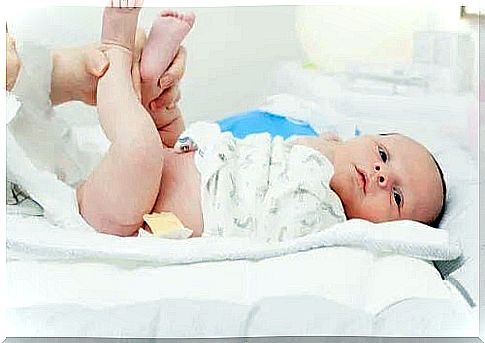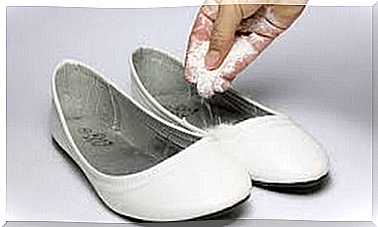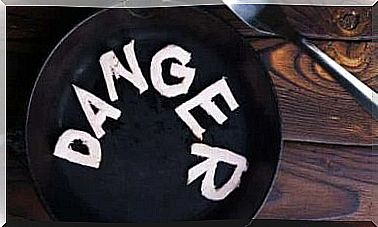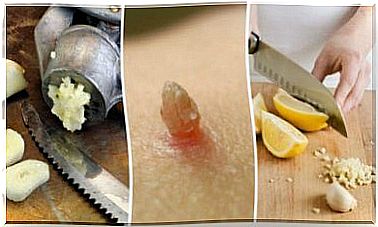Sacred Pit: How It Affects Children

Some babies have a small sacral pit. The sacrum is a bone located in the sacral area of the spine. The sacral pit can be a simple depression that does not lead to any discomfort. However, this dimple sometimes connects to the spinal canal and can cause problems in the nervous system.
In today’s article, we will tell you everything you need to know about the sacral pit and we will discuss its treatment.
What is the sacral pit?
As mentioned above, a sacral pit is a notch or indentation that appears in the lower back. It is present from birth. It is usually located just above the folds of the buttocks.
Most pits of this kind are harmless; however, a significant percentage is associated with spinal dysraphism. It refers to certain congenital anomalies that cause incomplete closure of certain structures, such as the spine, according to an article in the Acta Pediatrica.
It is a heterogeneous group of malformations that exposes neural tissue. The same study states that between 40 and 95% of children with spinal dysraphism have a type of skin disorder. It is a sacral pit in many of these cases.
The sacral pit is severe if it is close to a tuft of hair or if there are changes in skin color in the area. There may be neurological, urinary, rectal or even orthopedic problems due to neuronal damage. This is why it is essential to be able to distinguish a more serious problem and treat it in time.
Types of sacred pits
The sacral pit can be typical or atypical. This simple distinction makes the difference between a benign and a serious situation. A typical or simple sacral pit is small and is located in the fold between the buttocks. It is usually less than 0.5 cm in diameter and is close to the edge of the anus. It is a fairly common type and does not involve any risk of dysraphism. In fact, estimates indicate that almost 5% of healthy newborns have this defect.
In contrast, there are atypical dimples that are larger, with a depth of over 0.6 cm, located farther from the anus. They could be located near the sides.
An atypical dimple is a risk factor for spinal dysraphism. In fact, there may be abnormal communication with the spinal canal when it is very deep. The spinal canal is a sensitive structure through which many nerve fibers pass.
Thus, this communication channel can lead to damage to the spine and neurological problems. Also, this type of dimple can be accompanied by changes in skin color, nodules and even areas with unusual hair growth.
The difference between a sacral pit and a pilonidal cyst
A pilonidal cyst contains hair formations inside. It occurs in the intergluteal area, just above the buttocks.
In the case of pilonidal cyst, hair, cells, residual substances and fluids accumulate, resulting in a dense mass. It also develops after birth, is more common in men and often becomes infected. The result is severe pain and swelling.
The causes of the sacral pit
The causes of the sacral pit have not yet been identified, but we know that the problem is congenital. This makes it possible to differentiate from pilonidal cyst, as mentioned above.
Atypical pits can be derived from this defect in the closure of midline structures. However, we do not know why this problem arises.
Symptoms and diagnosis

In general, sacral dimples are asymptomatic. This is because they are just a skin change of the lower back. However, atypical sacral pits cause symptoms that depend on the correlation with spinal dysraphism. The doctor must perform a thorough physical examination to detect the type of pit.
Usually, the doctor measures and checks the characteristics of the pit and must perform a series of complementary tests if it is too large or deep. The same applies if there are several dimples, if there is discoloration of the skin or if the dimple is too far from the anus.
According to a study published in the Archives of Disease in Childhood , ultrasound is an effective method for studying sacral dimples. Estimates indicate a 6-fold increase in the probability of a spine problem when abnormalities are present.
Ultrasound is a preferred examination technique because it is fast, safe and inexpensive. However, there is always the option of an MRI if there are doubts about the diagnosis. This is a more accurate study of the tissues.
Possible complications
Atypical potholes have several complications and can be related to spina bifida or tied cord syndrome, among other conditions. Spina bifida is a congenital malformation. The neural tube does not close properly. There are different types, but the one related to the sacral pit is the spina bifida occulta.
Its main feature is a small gap in the spine, which occurs because the spine has not fully developed. It can be asymptomatic and is usually detected during adolescence or adulthood.
In contrast, tied cord syndrome occurs when there is scar tissue that anchors the spinal cord. It can lead to urinary and fecal incontinence, weakness in the lower extremities and even difficulty standing.
Treatment of the sacral pit
There is no treatment for the simple sacral pit, nor is it necessary. The only thing you need to do is prevent dirt from accumulating in the area to prevent infections. The pit is too close to the anus and intestinal bacteria could contaminate it.
Therefore, it is essential to clean this area properly, especially when changing baby’s diapers. An atypical sacral pit may require treatment, depending on its severity.

The procedure depends on the stage of the sacral pit
Ideally, all newborns should be carefully examined by a doctor. If a sacral pit is discovered, it must be analyzed. The process consists in measuring the pit and looking for possible anomalies.
The child should be in good health if everything is normal and the sacral pit is small. However, the baby will need a specialist if the dimple is atypical or there are other warning signs.
Doctors should closely examine the pit to find out if there are neurological changes or developmental defects. Also, the best treatment for a given case should be chosen based on the specific results.
Remember that most sacral dimples are harmless and represent a simple alteration of the skin. However, you should consult a doctor and rule out a neurological problem.









